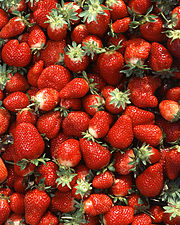



Strawberry cultivars vary remarkably in size, color, flavor, shape, degree of fertility, season of ripening, liability to disease and constitution of plant.[7] Some vary in foliage, and some vary materially in the relative development of their sexual organs. In most cases the flowers appear hermaphroditic in structure, but function as either male or female.[8]
For purposes of commercial production, plants are propagated from runners and generally distributed as either bare root plants or plugs. Cultivation follows one of two general models, annual plasticulture[9] or a perennial system of matted rows or mounds.[10] A small amount of strawberries are also produced in greenhouses during the off season.[11]
The bulk of modern commercial production uses the plasticulture system. In this method, raised beds are formed each year, fumigated, and covered with plastic, which prevents weed growth and erosion, under which is run irrigation tubing. Plants, usually obtained from northern nurseries, are planted through holes punched in this covering. Runners are removed from the plants as they appear, to encourage the plants to put most of their energy into fruit development. At the end of the harvest season, the plastic is removed and the plants are plowed into the ground.[12][9] Because strawberry plants more than a year or two old begin to decline in productivity and fruit quality, this system of replacing the plants each year allows for improved yields and denser plantings.[12][9] However, because it requires a longer growing season to allow for establishment of the plants each year, and because of the increased costs in terms of forming and covering the mounds and purchasing plants each year, it is not always practical in all areas.[12]
The other major method, which uses the same plants from year to year growing in rows or on mounds, is most common in colder climates.[9][10] It has lower investment costs, and lower overall maintenance requirements.[10] Yields are typically lower than in plasticulture.[10]
Strawberries are often grouped according to their flowering habit.[7][13] Traditionally, this has consisted of a division between "June-bearing" strawberries, which bear their fruit in the early summer and "ever-bearing" strawberries, which often bear several crops of fruit throughout the season.[13] More recently, research has shown that strawberries actually occur in three basic flowering habits: short day, long day, and day neutral. These refer to the day length sensitivity of the plant and the type of photoperiod which induces flower formation. Day neutral cultivars produce flowers regardless of the photoperiod.[14]
Strawberries may also be propagated by seed, though this is primarily a hobby activity, and is not widely practiced commercially. A few seed-propagated cultivars have been developed for home use, and research into growing from seed commercially is ongoing.[15] Seeds (achenes) are acquired either via commercial seed suppliers, or by collecting and saving them from the fruit.
[edit] Manuring and harvesting
Most strawberry plants are now fed with artificial fertilizers, both before and after harvesting, and often before planting in plasticulture.[16]
The harvesting and cleaning process has not changed substantially over time. The delicate strawberries are still harvested by hand.[17] Grading and packing often occurs in the field, rather than in a processing facility.[17] In large operations, strawberries are cleaned by means of water streams and shaking conveyor belts.[18]
[edit] Pests
Around 200 species of pests are known to attack strawberries both directly and indirectly.[19] These pests include slugs, moths, fruit flies, chafers, strawberry root weevils, strawberry thrips, strawberry sap beetles, strawberry crown moth, mites, aphids, and others.[19][20]
A number of species of Lepidoptera feed on strawberry plants; for details see this list.
[edit] Diseases
Strawberry plants can fall victim to a number of diseases.[21] The leaves may be attacked by powdery mildew, leaf spot (caused by the fungus Sphaerella fragariae), leaf blight (caused by the fungus Phomopsis obscurans), and by a variety of slime molds.[21] The crown and roots may fall victim to red stele, verticillium wilt, black root rot, and nematodes.[21] The fruits are subject to damage from gray mold, rhizopus rot, and leather rot.[21] The plants can also develop disease from temperature extremes during winter.[21]

No comments:
Post a Comment